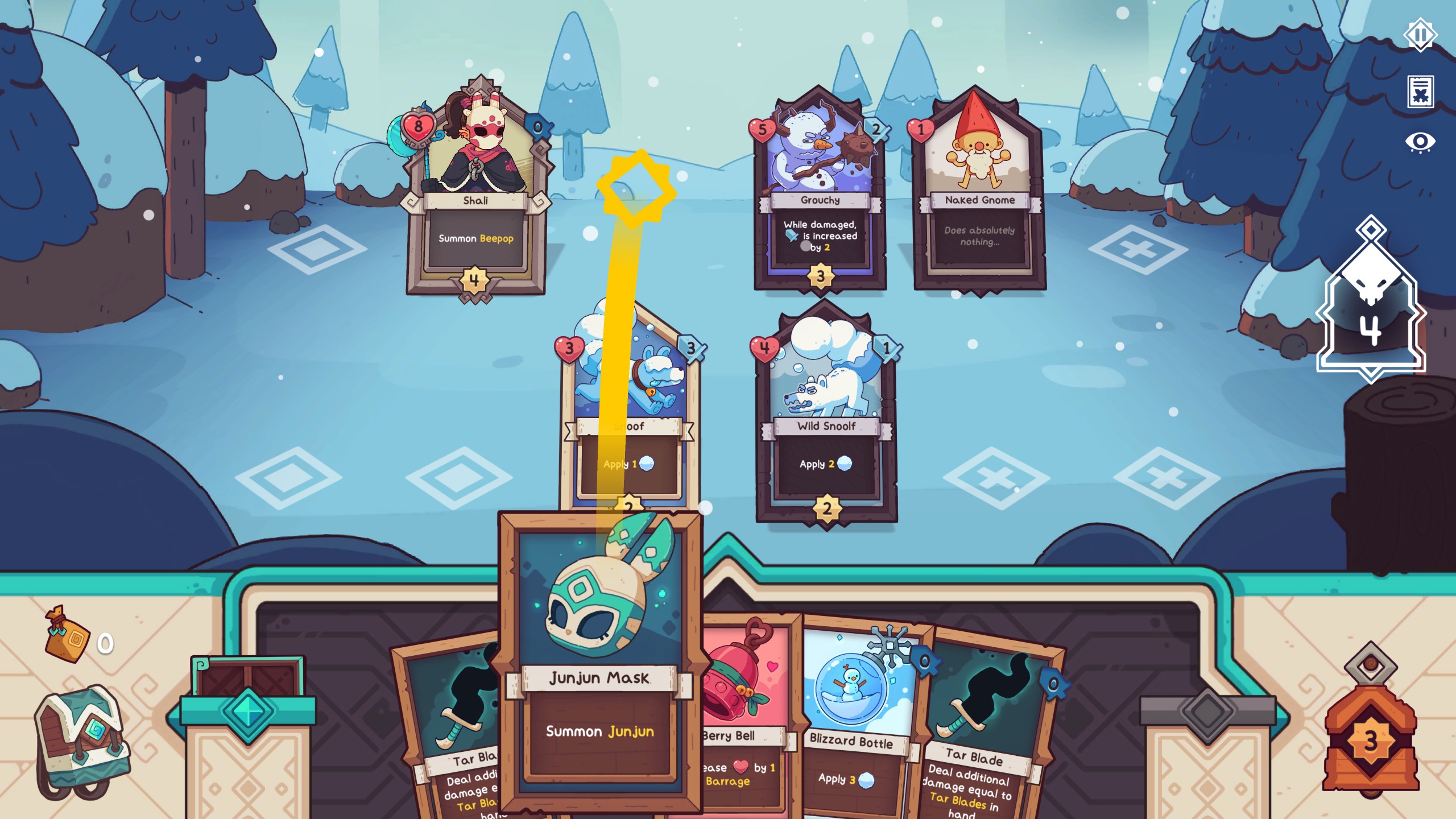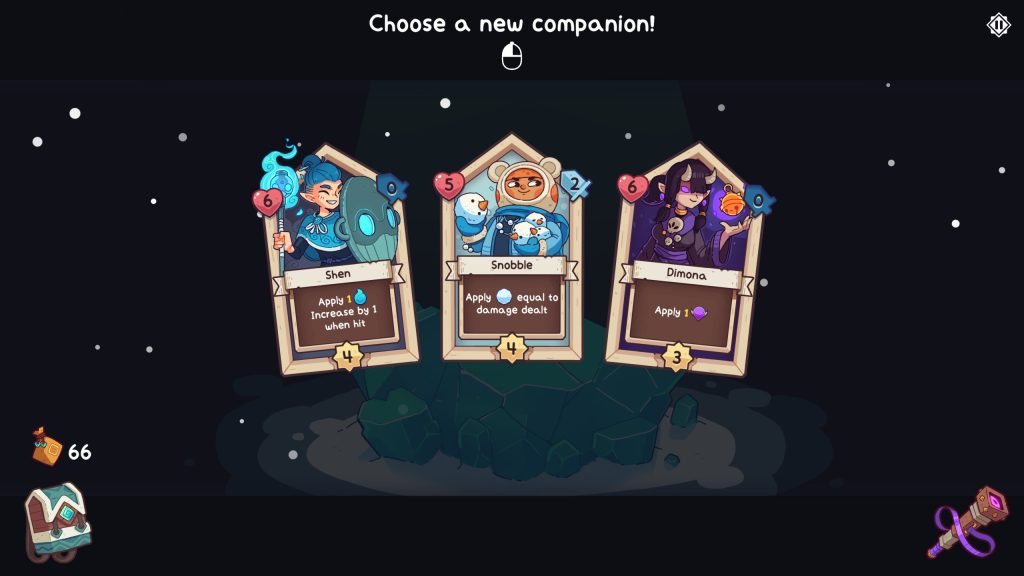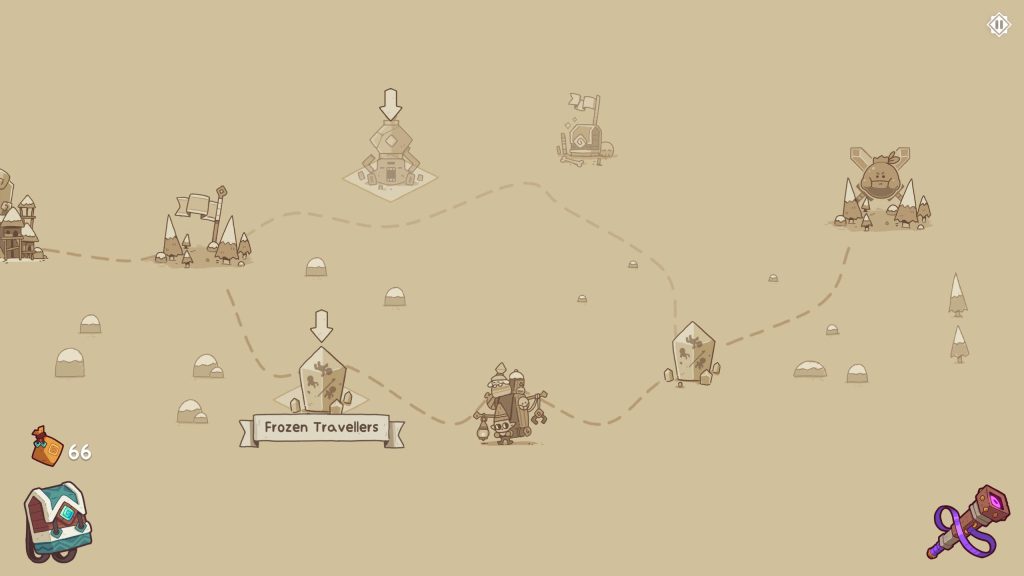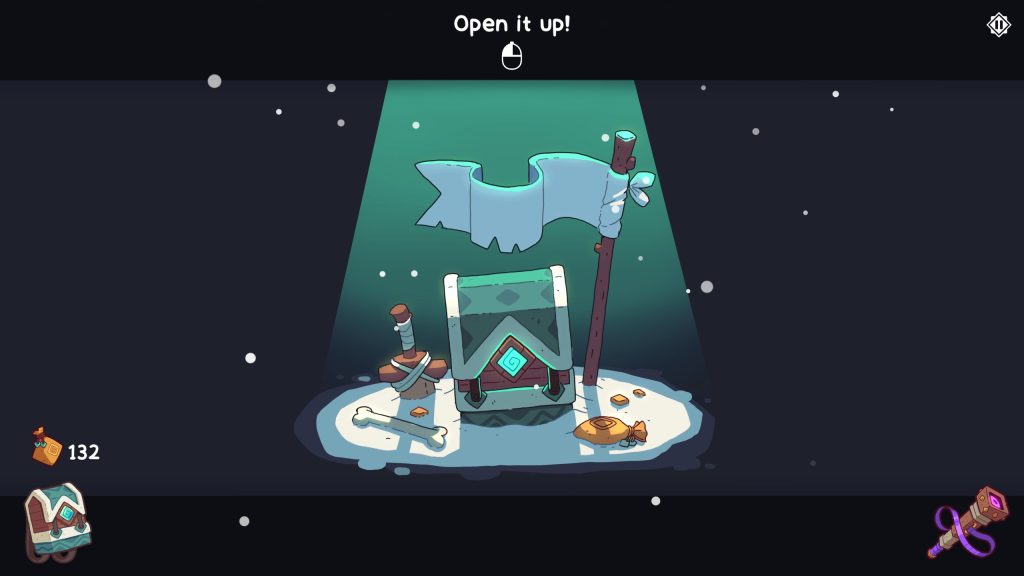
Wildfrost is a roguelike deckbuilder developed by Deadpan Games with character design and art by Gaziter. It joins a genre that's now well-established, but not yet exhausted. The niche is so popular that any new contender must establish a strong identity and unique gameplay variations to hold its own. Wildfrost may not have the sheer laser-honed balance of some of its contemporaries, but it delivers a compelling application of the core ideas and it stands out from the pack.
Wildfrost tells the story of a small band of tribes in a world cast into eternal winter, as they seek to restore the storm-shrouded sun. Each combat encounter takes place amidst two lanes, where attackers target directly across by default (though some attack in different ways). Moving cards around between lanes or returning them to your hand can be done freely, allowing the player to restructure their lineup in order to allocate damage appropriately. Between runs, the home base area can be upgraded and rebuilt to provide access to new hero cards, new tribes that have deploy different combat abilities, additional item cards, and more.
Changing Lanes

The most unique element — and perhaps the primary reason that Wildfrost is such a compelling entry to an already-stacked genre — is the ability to freely rearrange units across its two lanes in between turns. The turn only advances when a card is played or a hand is redrawn. Positioning units to focus down enemies, avoid dangerous counterattacks, tank hits, and make the most out of status effects is a strategic undercurrent that informs every single move the player makes.
The card draw economy is also interesting: an entire new hand can be drawn at any point at the cost of a turn. Once enough cards in the current hand are exhausted, the redraw action becomes free and no longer incurs a turn, allowing you to refill your hand without consequence once you've mostly emptied it. This means that a couple of bad draws won't really be enough to end a run. Typically, a truly bad hand can be thrown away early to cycle in better cards. Decks start out small, not crowded by too many generic actions, making the decisions to modify them feel very impactful.
Over the course of a run, various upgrade stations will introduce new hero cards, provide charms that can upgrade existing cards to enhance their effects or add new ones, or allow various other benefits. The sequence of map nodes explored feels like a very pared-down version of Slay the Spire's map, with fewer but slightly more impactful choices. Balancing your choices becomes its own strategic layer as new late-run difficulty barriers come into focus. Since many of the home base upgrades are tied to specific actions and feats to be performed during runs, the progression system encourages variation of playstyle and tactics.
One Wrong Move

Wildfrost's combat encounters start simple, but the complexity ramps up sharply. A single successful run is not especially long, so the escalation can feel breakneck at first. This is, ultimately, a good thing. It means that the earlier fights that you quickly work out will not be taking up a major portion of your time as you push to reach further into your runs, and that no individual loss is too catastrophic. Run-ending missteps can be brutal and sudden, the result of a single small miscalculation unraveling into myriad consequences. It's harrowing, but it feels increasingly more fair with the quality-of-life improvements that the developers have made to over the course of the nine months or so since launch.
The information economy has improved meaningfully since release, clarifying the sequences of events that will occur on the next turn and indicating when certain modifiers will increase damage output. It still demands a fair bit of mental calculus and attention to detail, which can easily get away from you if you're not cautious, but it's trending towards a place that feels substantially more accommodating. Even though the rules can be discovered and internalized by trial and error, the UX improvements that Wildfrost has made bring it closer to fully justifying those swift, bitter defeats. You can only say "I didn't think that would happen" the first time you see something happen.
Despite the steep shifts in challenge level, Wildfrost retains a tremendous degree of charm due to its dynamism and efficiency. To top it off, the aesthetic elements that surround the game design are an absolute delight. Character and enemy art, contributed by artist and character designer Gaziter, is endlessly cute and expressive. Paul Zimmermann's soundtrack is full of folk instrumentation and catchy, syncopated little movements that amp up the sense of drama without ever overshadowing the action of the game itself. Even when I have a podcast on in the background during a run, I'll always want the game's own soundscape playing just underneath it — it's simply too good and too fitting to be silenced.
Conclusion

Wildfrost launched in April of 2023, only a week or so before I spent three weeks traveling. It was perhaps not the most relaxing companion to have while I was abroad, but it was certainly an engrossing one. I was following along with several friends who were also playing it at the same time, collectively celebrating each others' victories, commiserating over abrupt defeats, and rolling our eyes at that one friend who's insufferably good at this kind of game.
Wildfrost is also one of the only games I've picked up on and off all year as a palette cleanser or for a bit of variety. It's a little too intense to call it "cozy", but it's comfortable to return to periodically. I'm really delighted to have found my latest one of these to pick at from time to time. Whether it's consuming all of my attention or just something I pick up for a quick run every so often, I think it's going to remain in the "ongoing" status in my game tracker for a while longer.